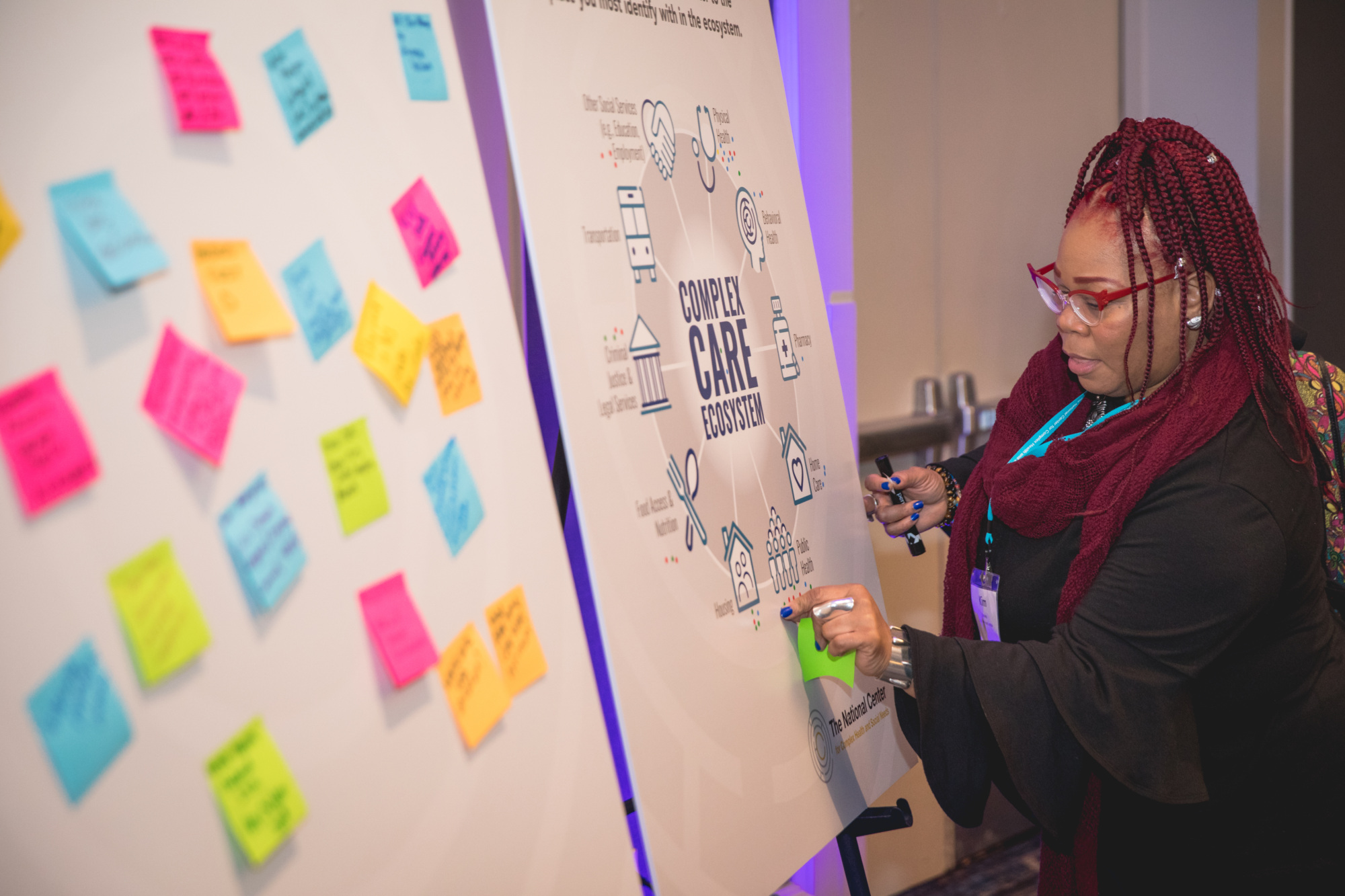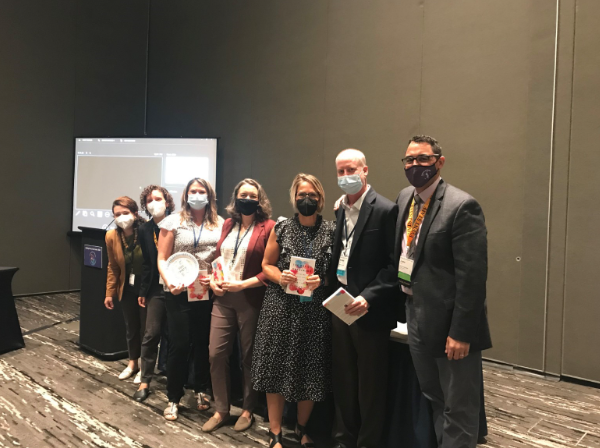Measuring our impact: Strengthening ecosystems of care in Camden and beyond
Our new Ecosystems of Care Assessment Framework defines the six domains of a strong ecosystem and provides a rubric for measurement with the goal to provide a structure for improvement at an ecosystem level.
Community & consumer engagement Data analysis & integration Strengthening ecosystems of care Data sharing Measurement & evaluation SDOH & health equity

The authors want to acknowledge the extensive contributions of Audrey Hendricks, Danielle Hodges, Evelyne Kane, Shelby Kehoe, Kathleen Noonan, Amadly Remias, Stephen Singer, Morgan Steward, and Dawn Wiest to this work.
For years, the Camden Coalition has invested in the creation and nurturing of ecosystems of care as a solution to the siloed and fragmented health and social care systems in the U.S. From our origins as a hyperlocal coalition of organizations providing direct care to program participants to our current recognition as a national leader helping to build the field of complex care, we have seen firsthand the improvements in quality and outcomes that result from an interdependent network of organizations working collectively across sectors within a community. We have come to define such networks as “ecosystems of care” — where collaboration across organizations and sectors is essential to overcome the disconnected systems that exacerbate the complex needs of vulnerable populations.
As an ever-evolving organization seeking to improve our services and respond to the needs of the people we serve, we recently underwent a strategic planning process to identify specific goals to achieve our mission. In doing so, we leaned into our ecosystem approach, setting a bold goal for ourselves to “Confront inequities and system failures by strengthening ecosystems of care for 500 communities in Camden, across New Jersey, and around the country.” We knew we needed a needed a method to assess our progress.
Based on our experience strengthening our own ecosystem in Camden and working with others around the country to strengthen theirs, we began by defining the key domains of high-performing ecosystems. We then developed a rubric to measure the impact of our work in these key domains.
As we began working with our partners in the ecosystems we serve to pilot our new framework and measurement tool in our programmatic work, we found that both had broader applicability beyond our own organization’s efforts. After testing our framework in multiple pilots, we realized this approach increased clarity of a collaboration’s objectives and offered a standard set of attributes that were fairly easy to measure across sectors, organizations and projects. And while there exists an abundance of individual-level data in the complex care field that track improved outcomes, our new methodology yields metrics around the systems-level domains that are necessary to facilitate positive and sustainable change.
We realize that the domains in our Ecosystems of Care Assessment Framework are not exhaustive in terms of factors that impact an ecosystem of care. We also acknowledge that other frameworks – such as the Levels of HRSN and SDH Integration Framework from Health Begins or the National Academies of Sciences, Engineering, and Medicine’s Integrating Social Care into the Delivery of Health Care: Moving Upstream to Improve the Nation’s Health – may have overlapping or complementary domains based on the focus of the work.
However, we believe our framework will be helpful to the larger complex care field as we continue to refine our understanding of the key domains and attributes to focus on for quality improvement initiatives at the ecosystem level. This framework can help identify the most impactful levers and approaches for addressing whole-person health and social care needs through cross-sector collaborations and alignment.
Our Ecosystems of Care Assessment Framework defines six essential domains of a strong ecosystem of care — and their corresponding attributes — in order to best serve communities that can vary greatly by geography and populations of focus.
The six domains are:
- Workforce – In a high-functioning ecosystem, the workforce is well-prepared, diverse, interprofessional, and supported to deliver high quality, person-centered care. It should also include people from the community being served and those with lived experience in clinical and non-clinical roles.
- Services – Ecosystem partners must continuously evaluate the continuum of services needed by the population(s) being served to confirm that services are accessible and effective. This ensures screenings are actionable, service gaps are filled, and care management supports individuals to achieve their identified goals in a timely manner.
- Data and measurement – Participating organizations in an ecosystem of care should generate, share, and use quantitative and qualitative data to identify and understand their populations served, assess needs, coordinate services, adapt best practices, and continuously measure and improve the delivery of care and support.
- Leadership and governance – In a strong ecosystem of care, there is a well-functioning process and structure for identifying priorities, designing and improving services, and collaborating with all relevant stakeholders, including community leaders and people with lived experience. Leaders recognize the power differentials among participants and seek to share power.
- Payment and funding – Resources and payment arrangements are directed to the organizations and services that are essential to improve the health and well-being of the participating population, particularly community-based organizations (CBOs) and those providing non-medical services for health-related social needs.
- Consumer participation – Community members and people with lived experience are key stakeholders who are meaningfully engaged in shaping all aspects of care delivery, program design, quality improvement, and governance.
While each of the six domains is a discrete factor critical to a strong ecosystem, there is significant interplay among them. For example, a strong, shared health information infrastructure (an element of the Data and Measurement domain) can enable and accelerate collaboration between and among various health and social care providers, including shared care planning (an element of Services). Similarly, without adequate and flexible payment structures (Payment), it’s hard to overcome the scarcity of resources to address health-related social needs (Services). Moreover, a community with advanced Payment and Data may struggle to create impact without well-trained staff from the community (Workforce) and sufficient collaboration among organizational leaders (Governance and leadership).
The Ecosystems of Care Assessment Framework also breaks each domain into subdomains that describe the domain’s key attributes and offer more concrete areas of focus to evaluate an ecosystem’s strength and efficacy. For instance, subdomains under “Workforce” include “Teaming & Collaboration,” “Training,” and “Community Representation.” Additional subdomains are mapped below:
By thus defining the components of a strong ecosystem of care, organizations within an ecosystem can more accurately pinpoint where improvement is needed, especially if they assess what level of maturity or improvement they are current at based on the measurement rubric described below.
Measurement
With the domains and subdomains defined, we needed to develop a rubric to measure our impact. Our framework uses a maturity model, in which each domain and subdomain are qualitatively described along a continuum, from limited practices (Level 1), promising practices (Level 2), strong practices (Level 3), through to advanced practices (Level 4). Half scores are honored if organizations have implemented some areas of the subdomain but not all.
We start with a baseline rating across all relevant domains and sub-domains, and then assess areas for improvement. At least one more assessment is conducted at the end of a phase or a project.
Our expectation is that each assessment focuses on one to three domains out of the six. Strengthening an ecosystem of care requires concentrated effort on a limited set of factors to create sustained improvements in care, equity, and collaboration. In our experience, it is important to be focused on improvement efforts and not try to advance all of the domains at once. Incremental improvements in one domain can strengthen a community’s culture of collaboration and create the conditions for future improvements in other domains.
The Ecosystems of Care Assessment Framework offers a useful roadmap of a community’s current state of coordination and collaboration among local healthcare, social care, and other community organizations, including people in the communities being served, and where it wants to go. This can be useful for quality improvement as well as allocation of resources.
We have found that application of the tool to projects and initiatives can generate extremely productive cross-partner conversations about how to achieve the most significant and sustainable impact. The results can also be shared with leadership to document progress and show return on investment.
More broadly, the tool names the components of meaningful collaboration across sectors and provides measuring the impact of the work. In this way, working interdependently and as a collective becomes a measurable skill, organizations can develop and measure in their goal to achieve better outcomes for the communities they serve.
To learn more about the framework and how you can implement it into your own ecosystem of care, email [email protected].
Related resources



Ecosystems 101
By Rebecca Koppel, Senior Program Manager for Field Building and Resources
Building the complex care field Strengthening ecosystems of care Quality improvement SDOH & health equity
Rethinking value: Perspectives on the benefits of cross-sector collaboratives serving populations with complex health and social needs
Data analysis & integration Strengthening ecosystems of care Funding & financing Measurement & evaluation
Related blog posts

